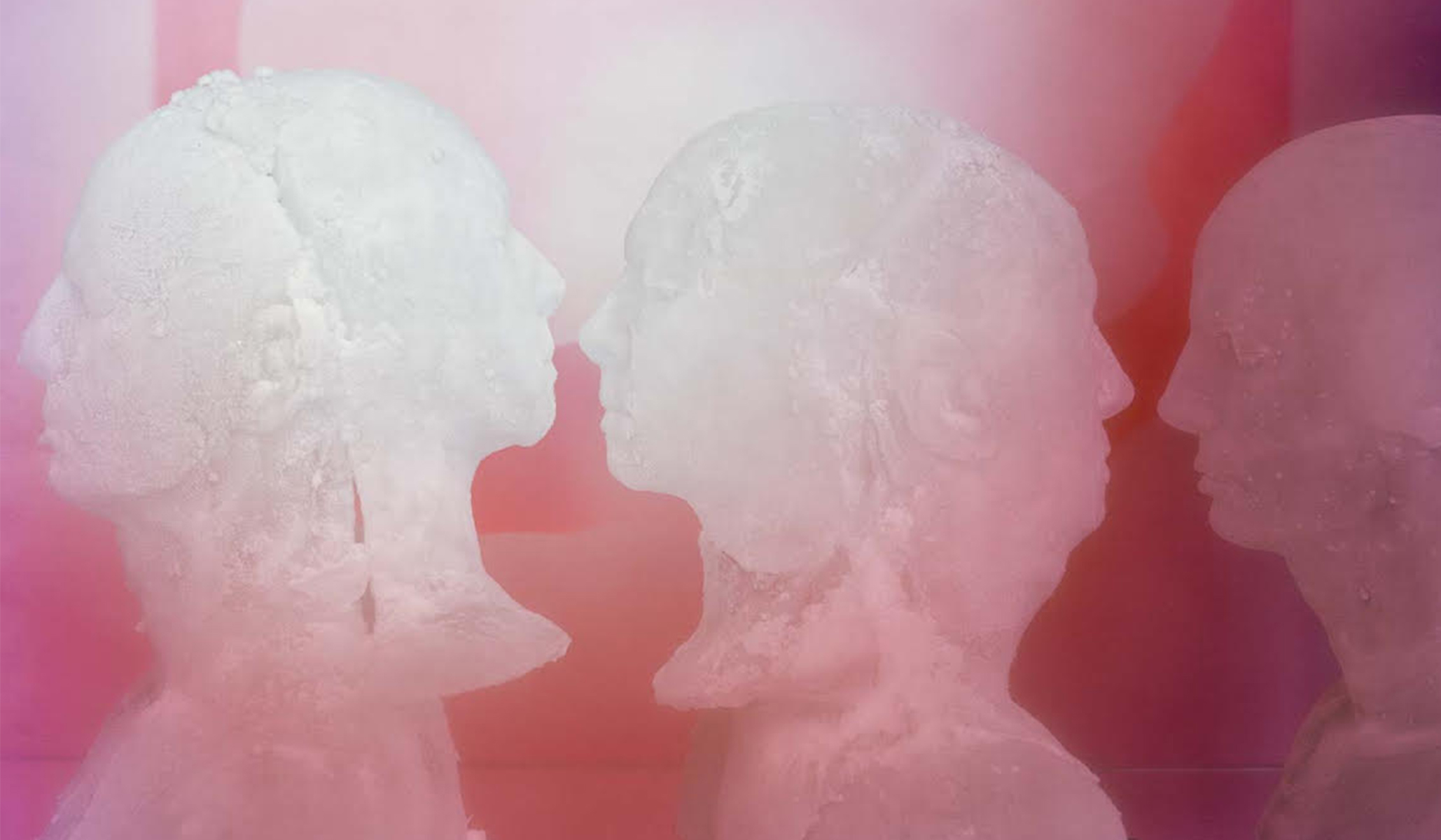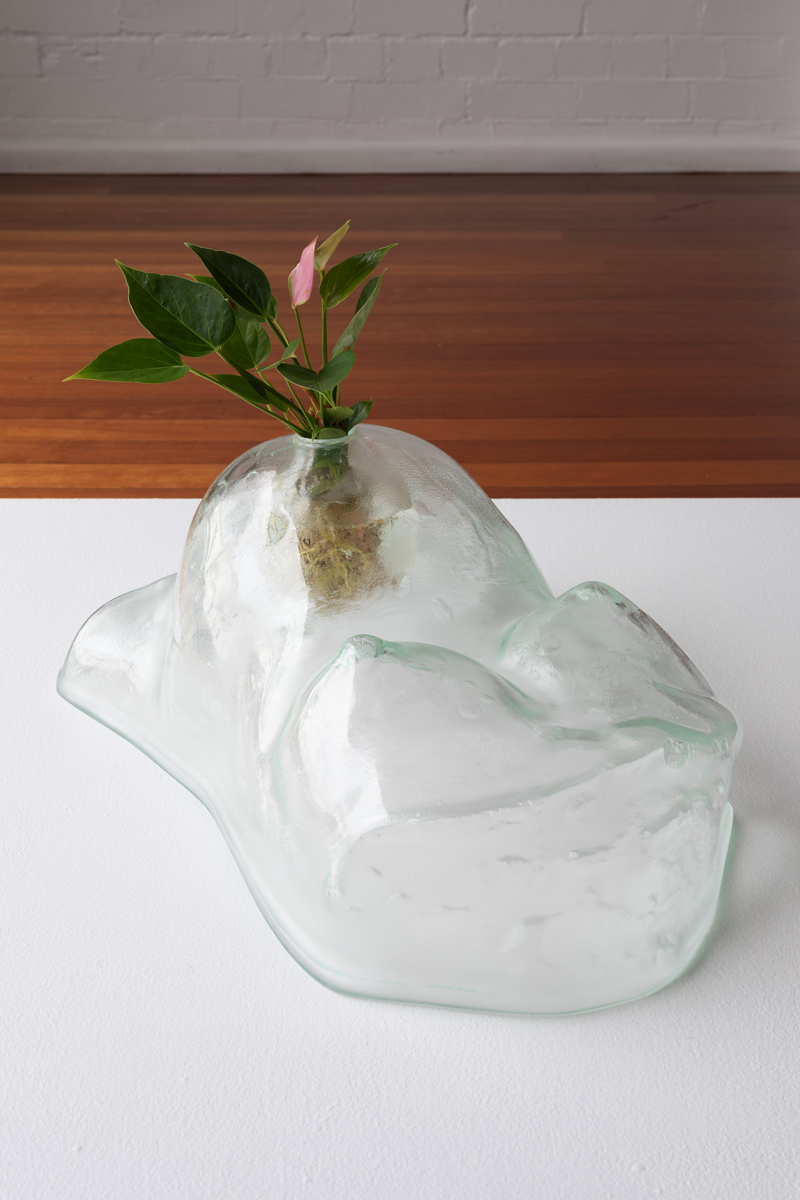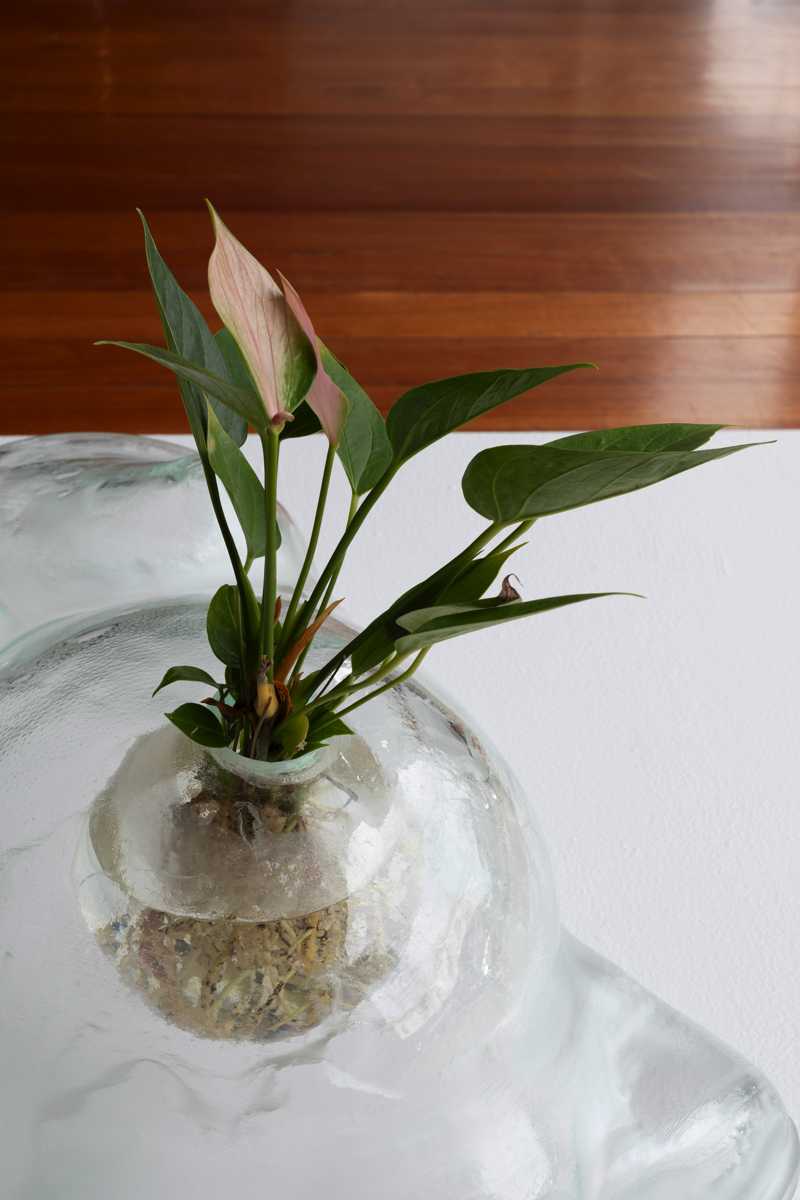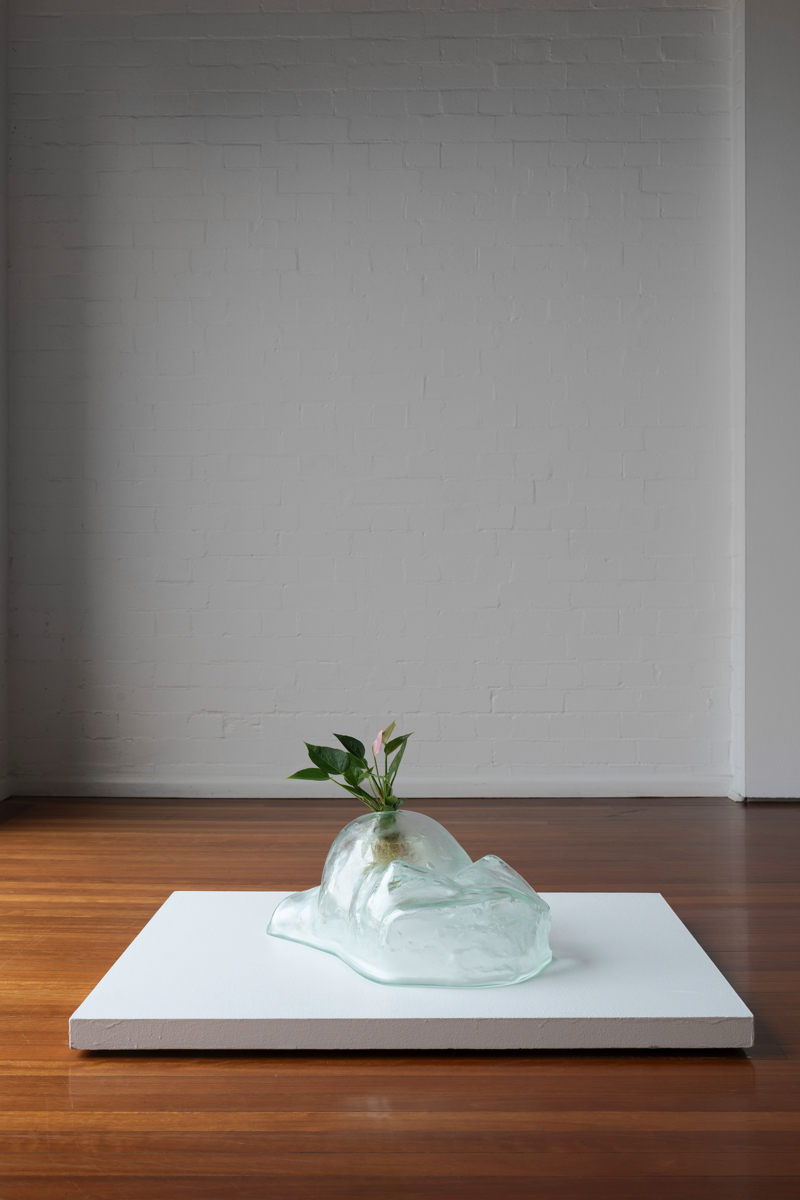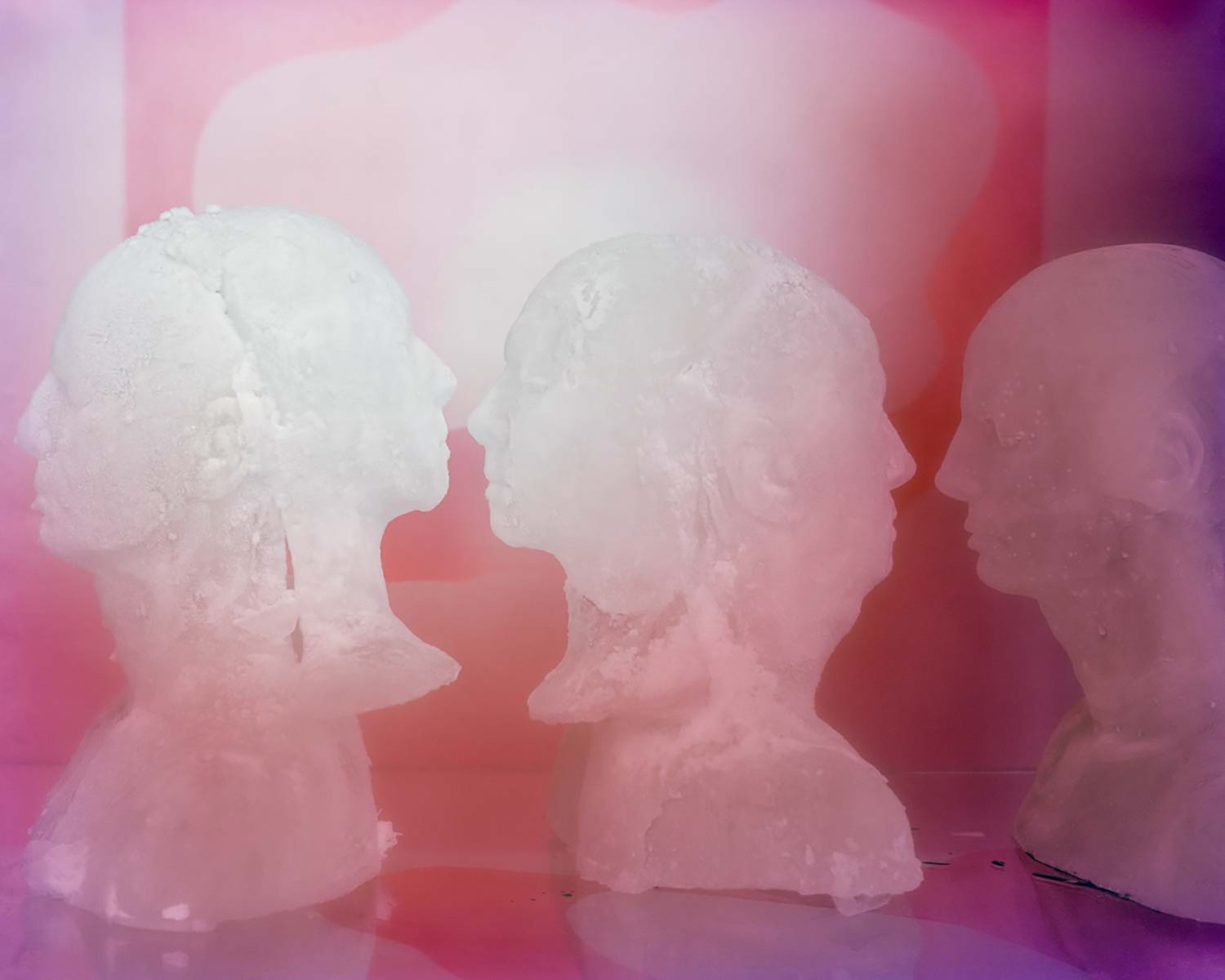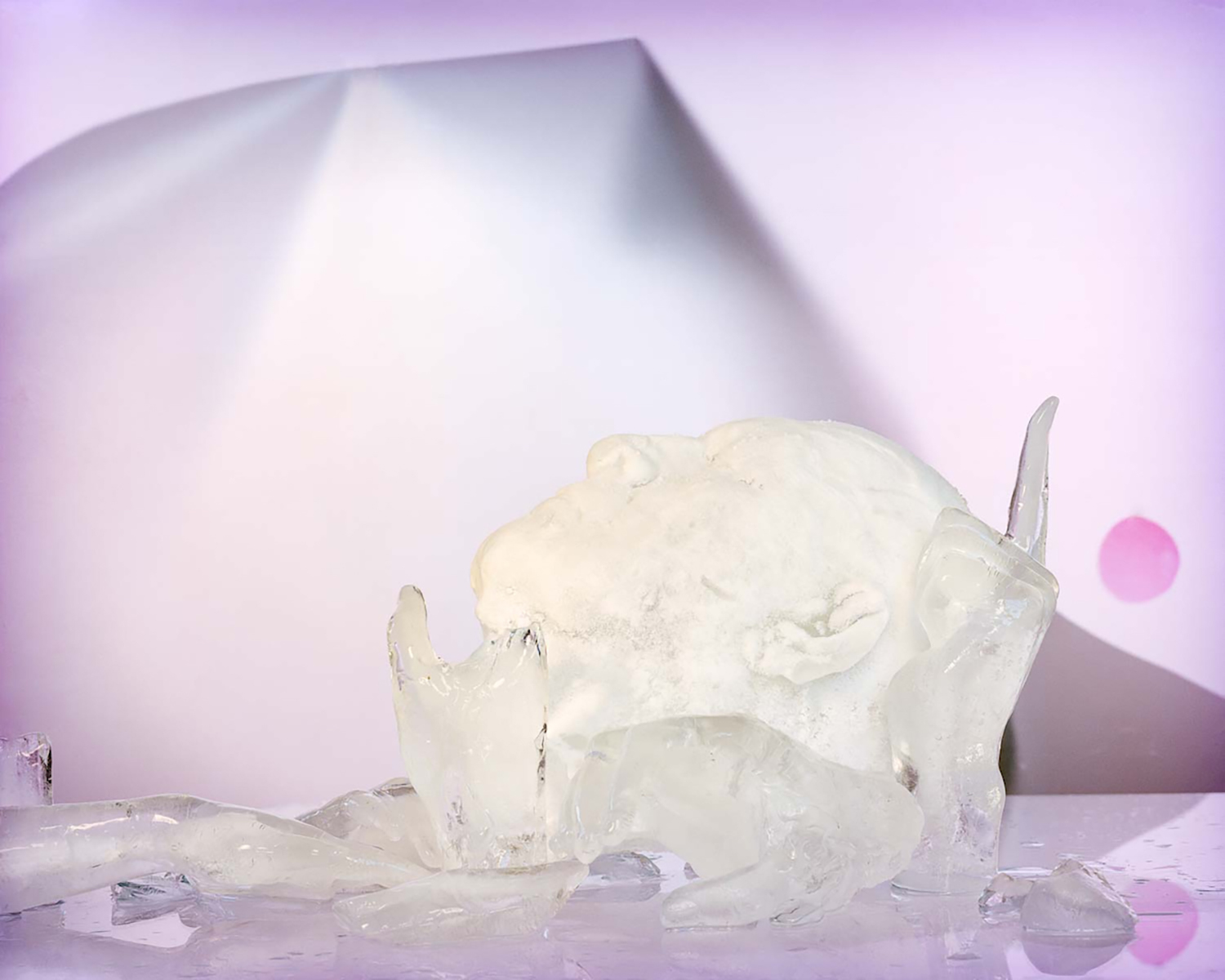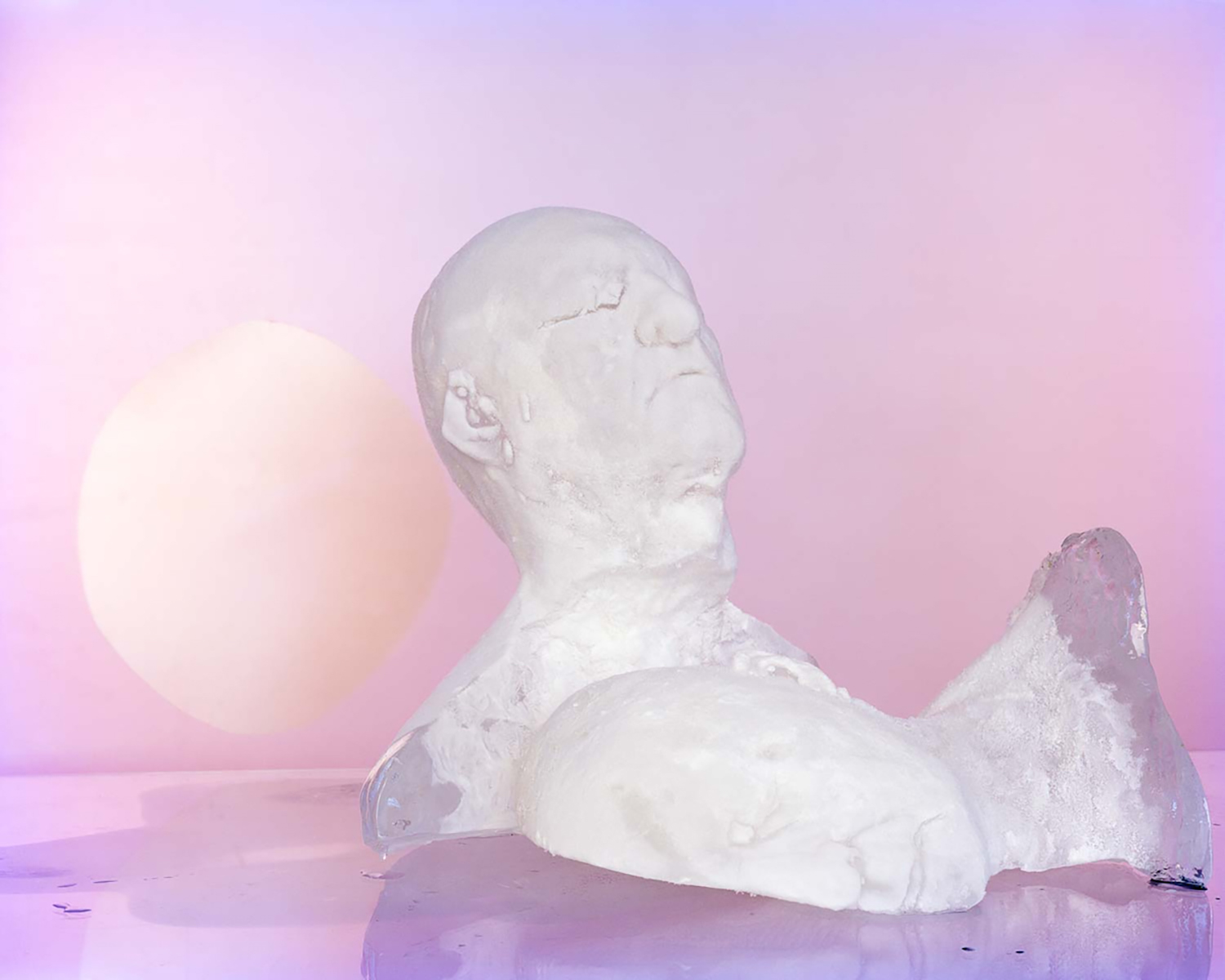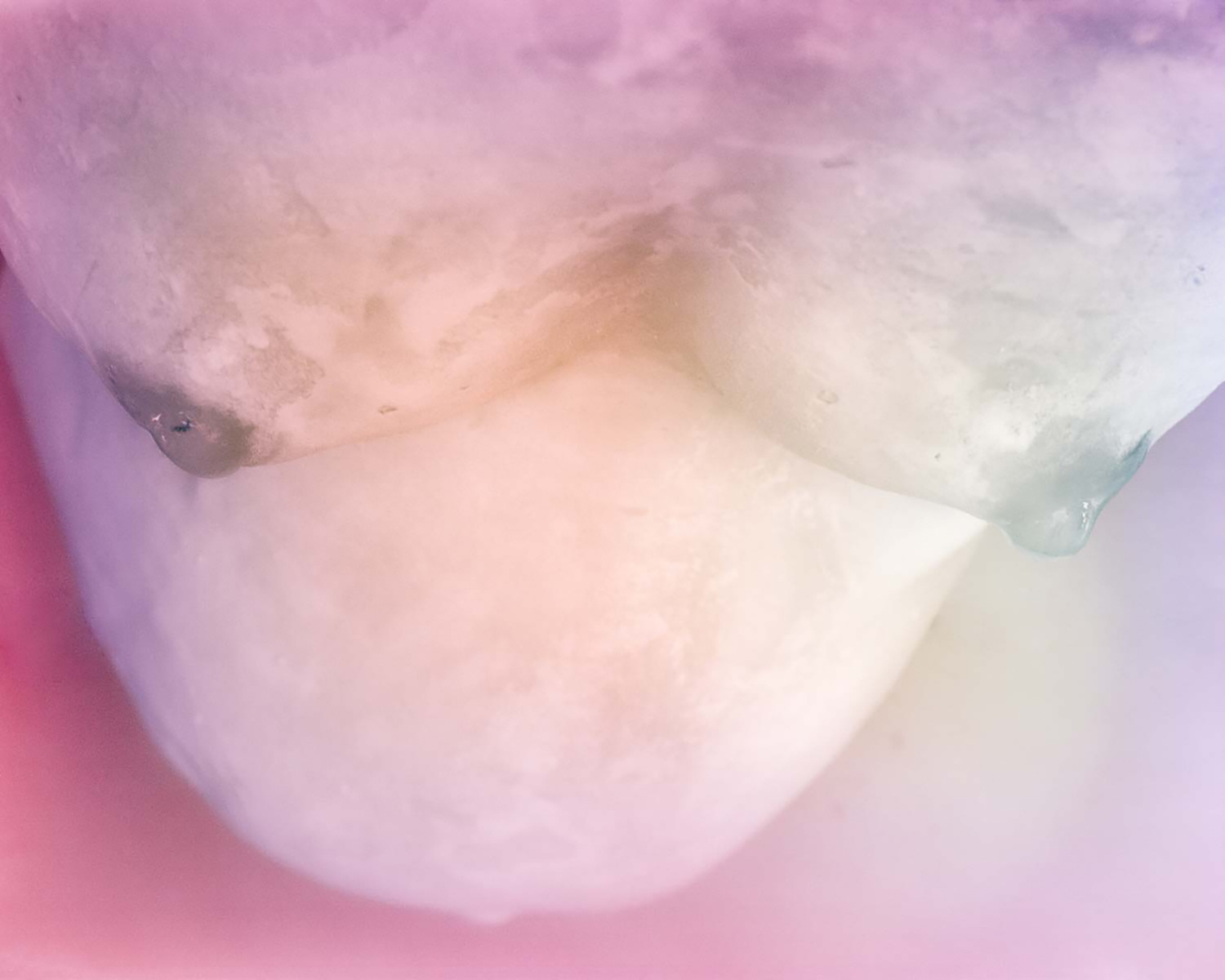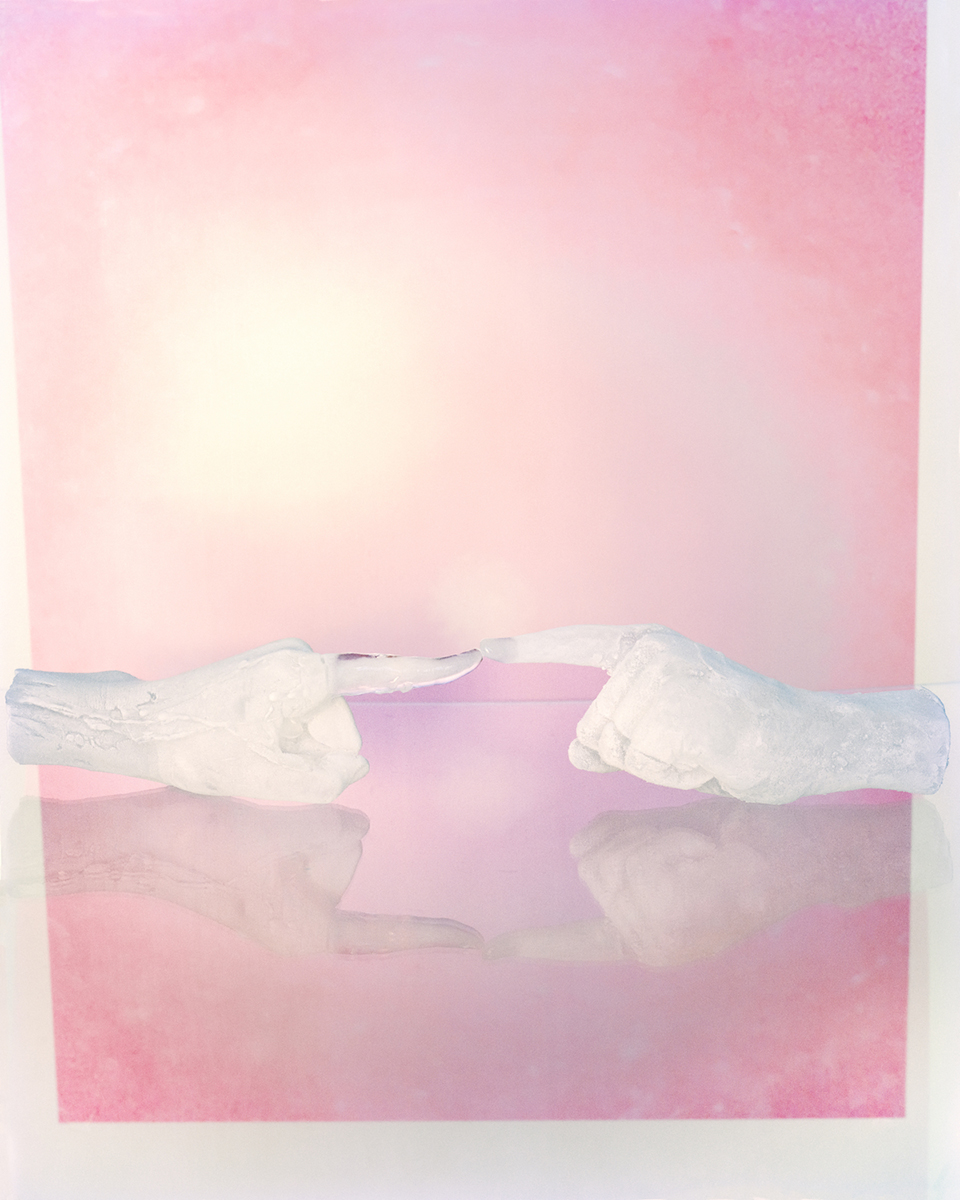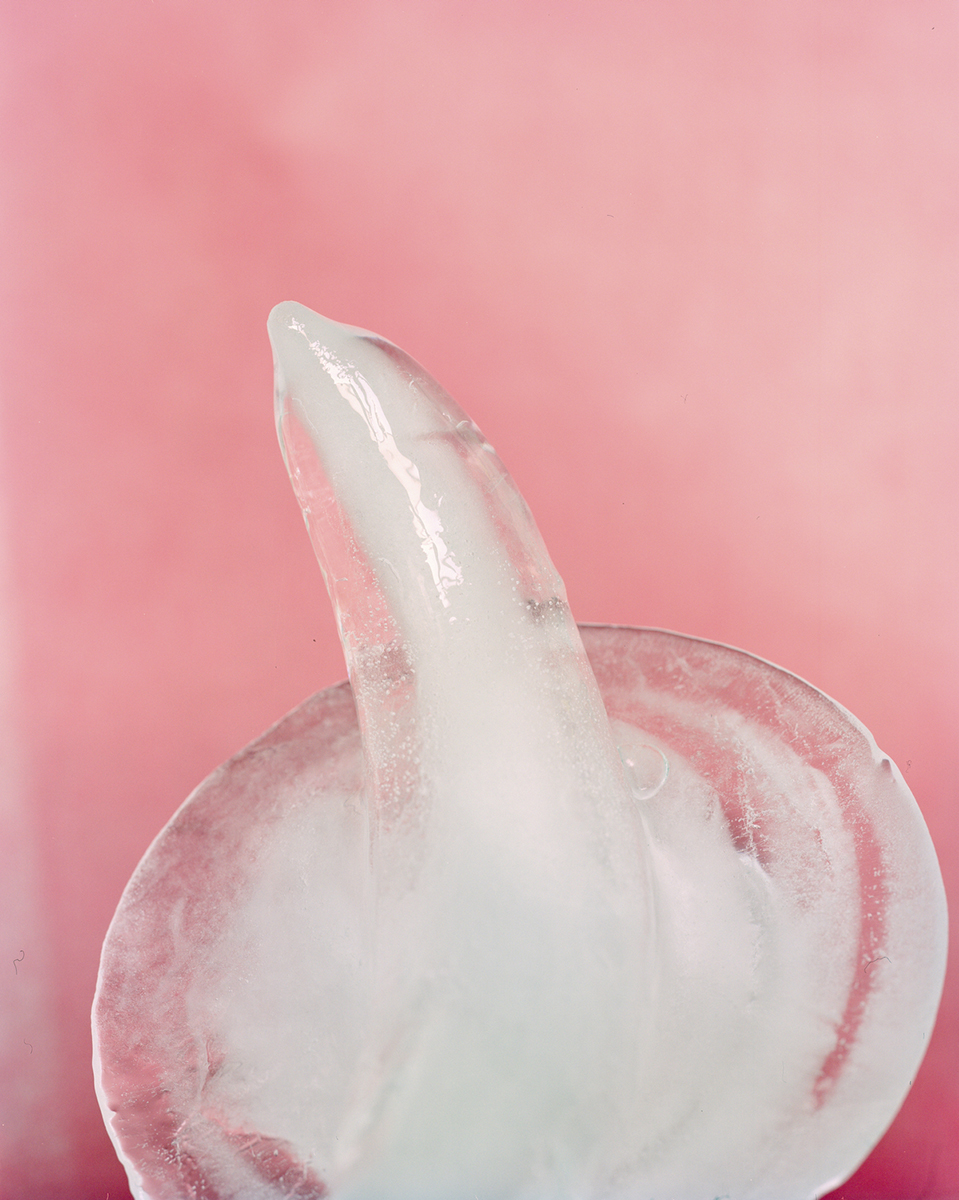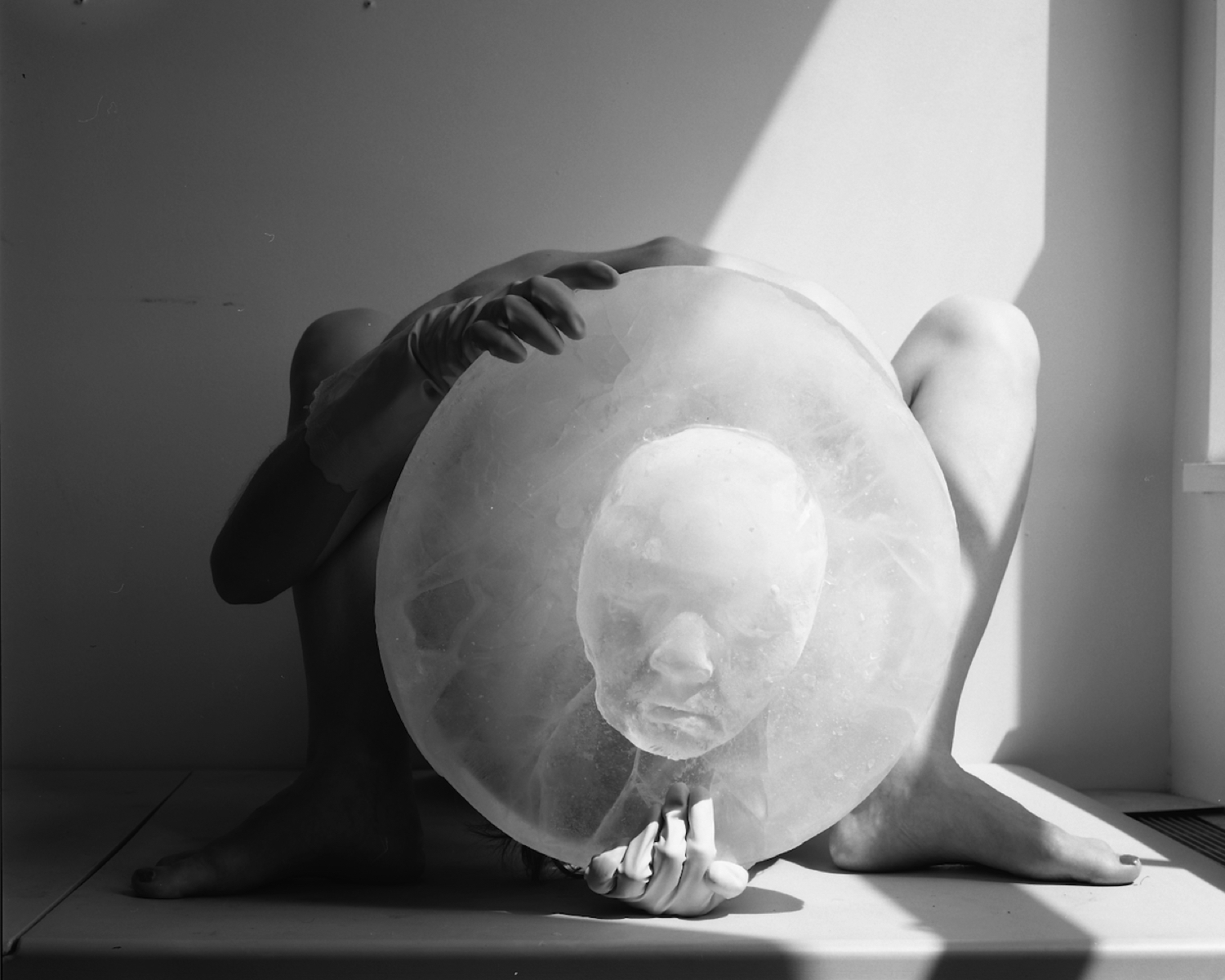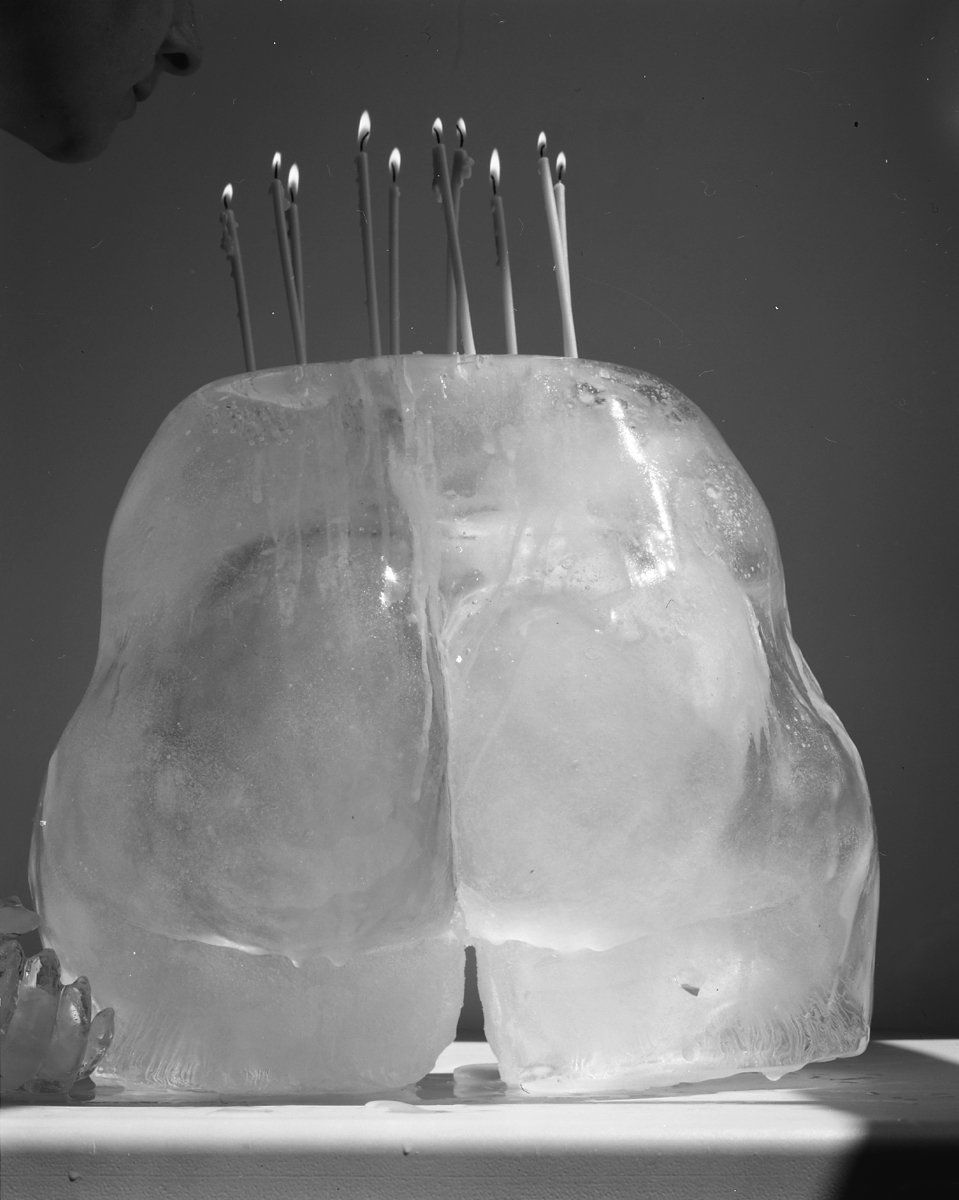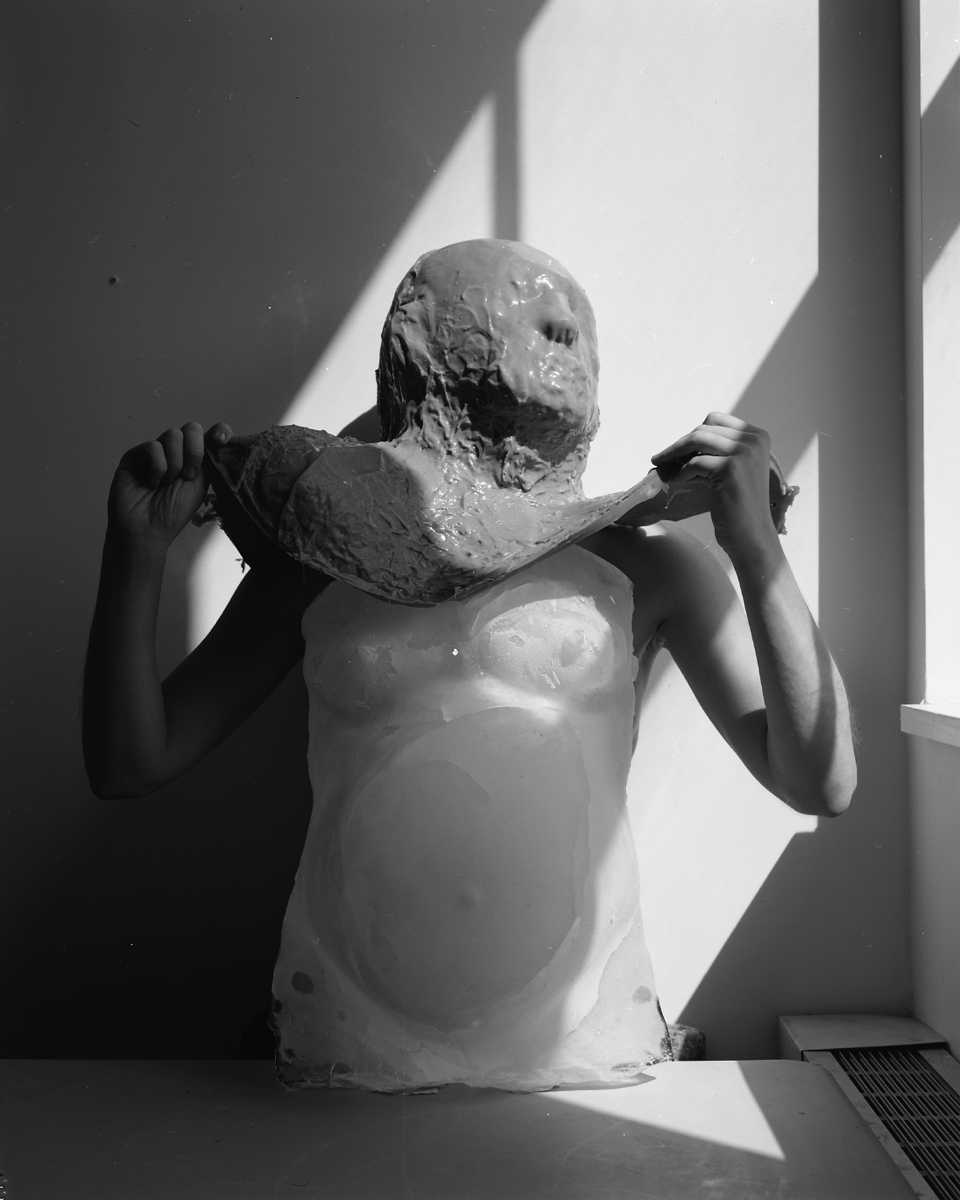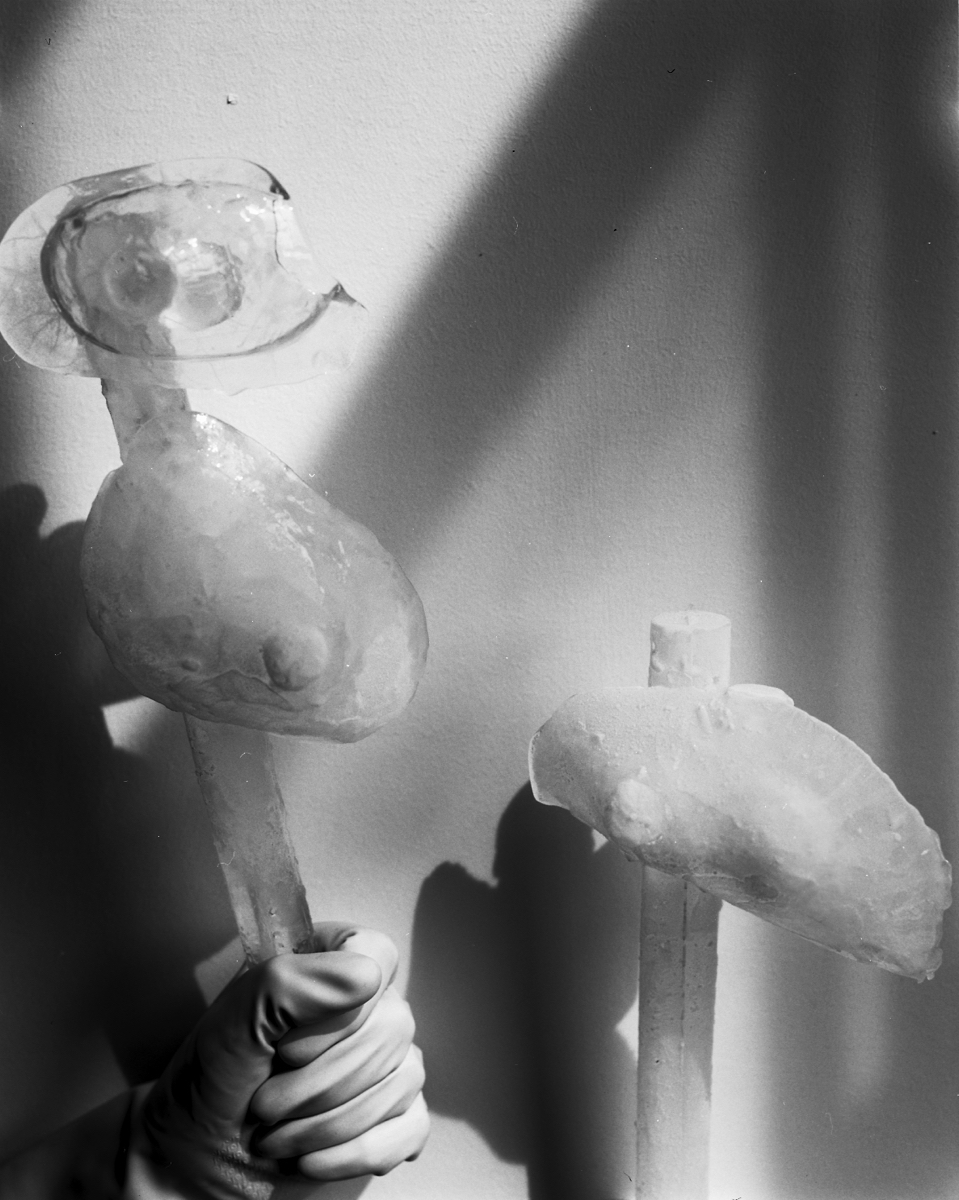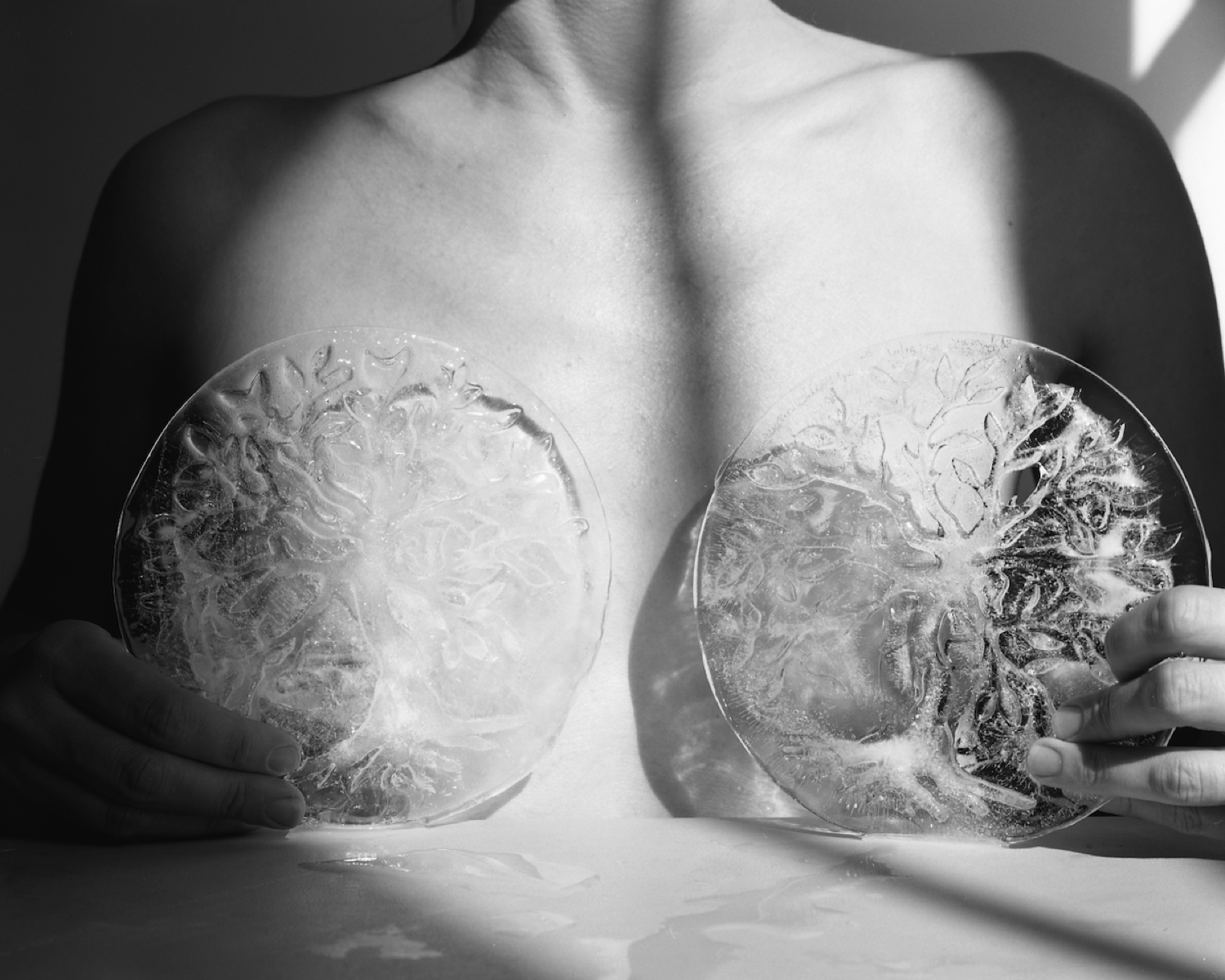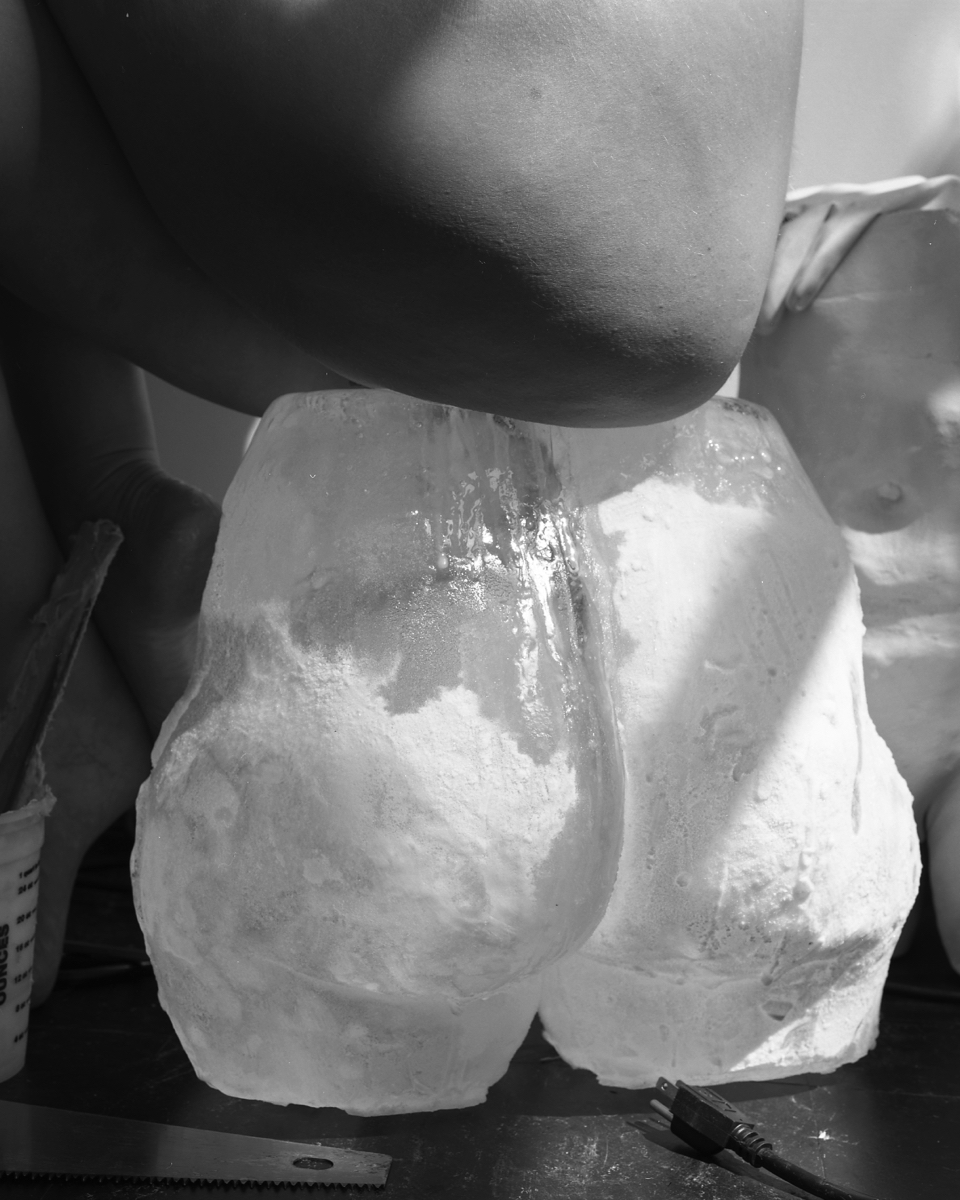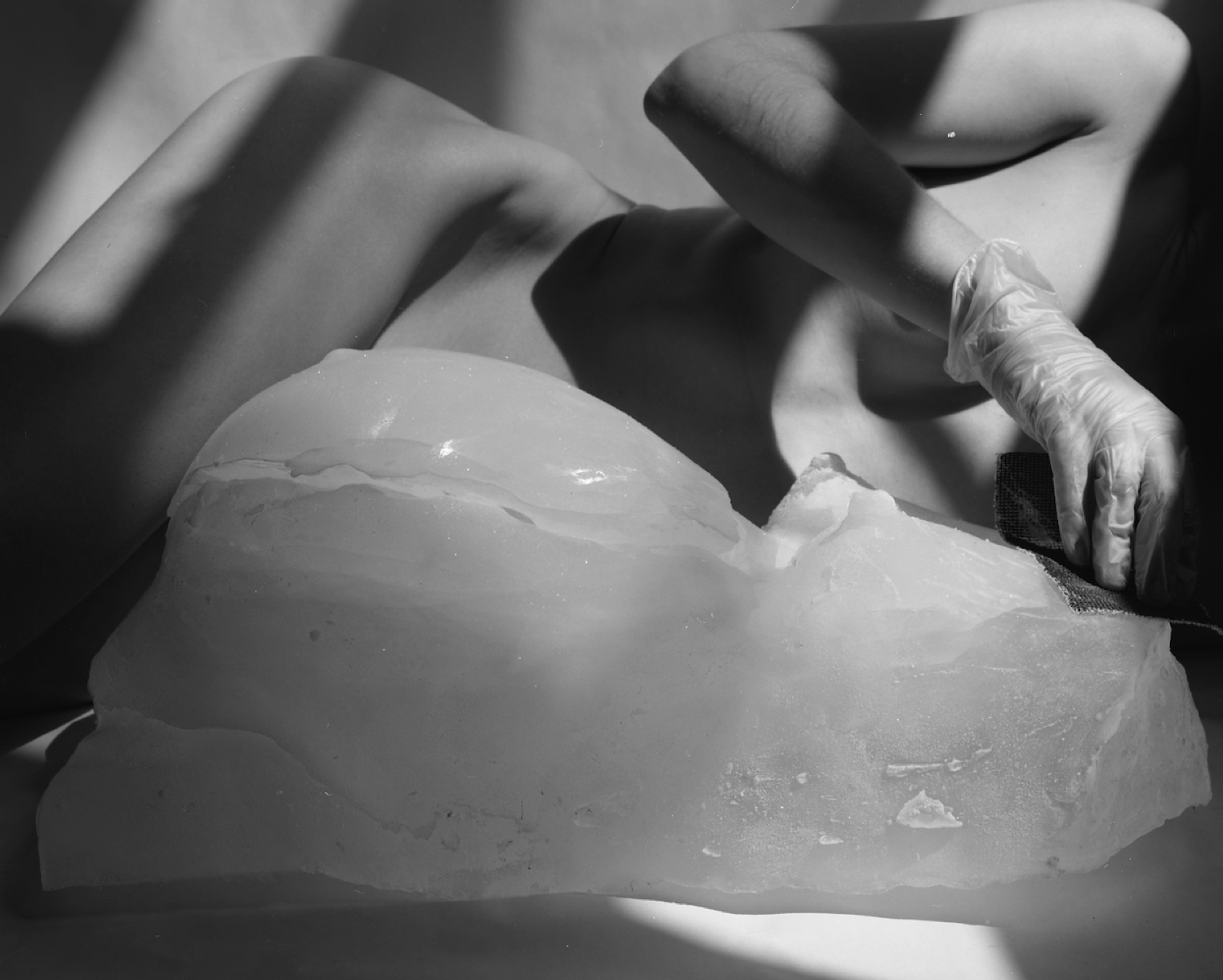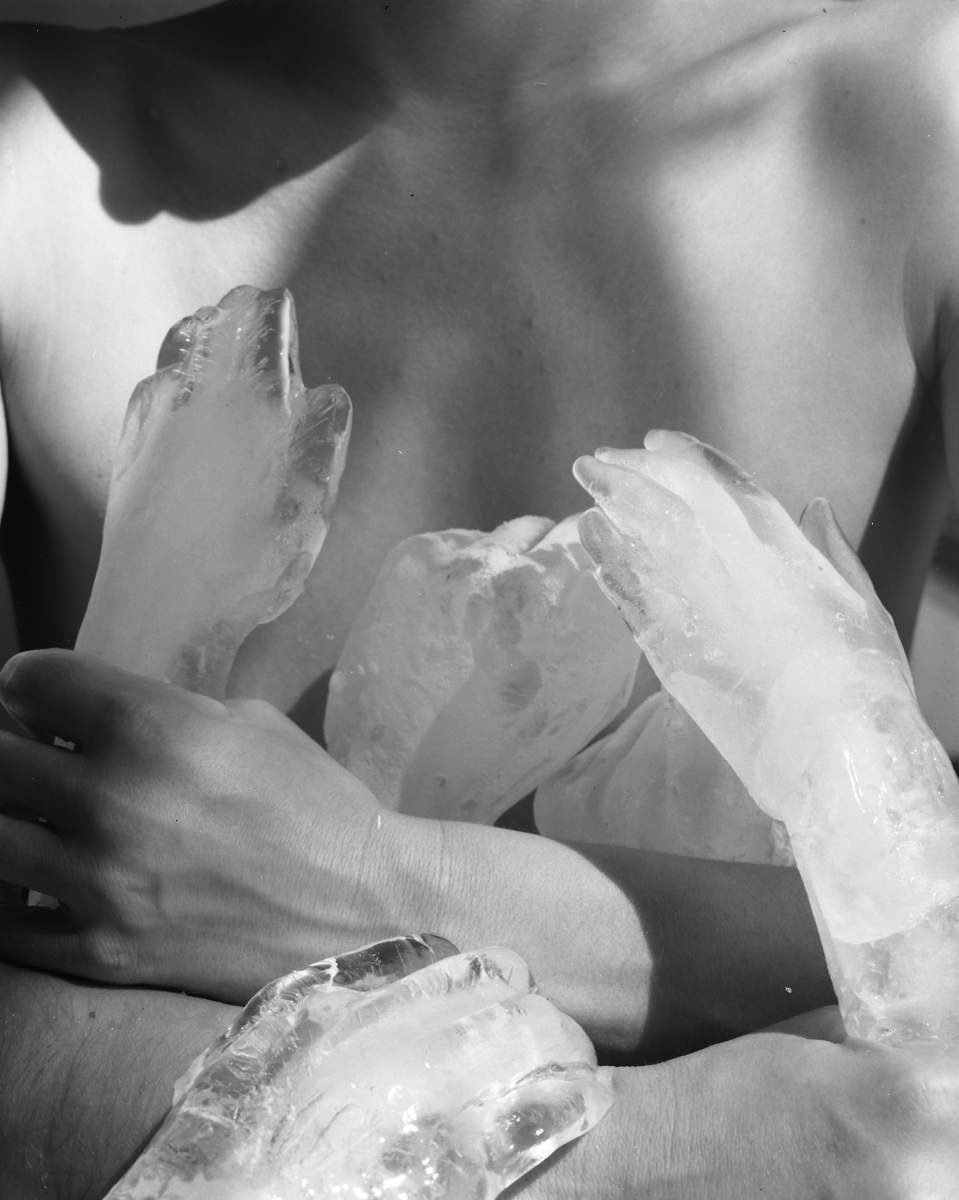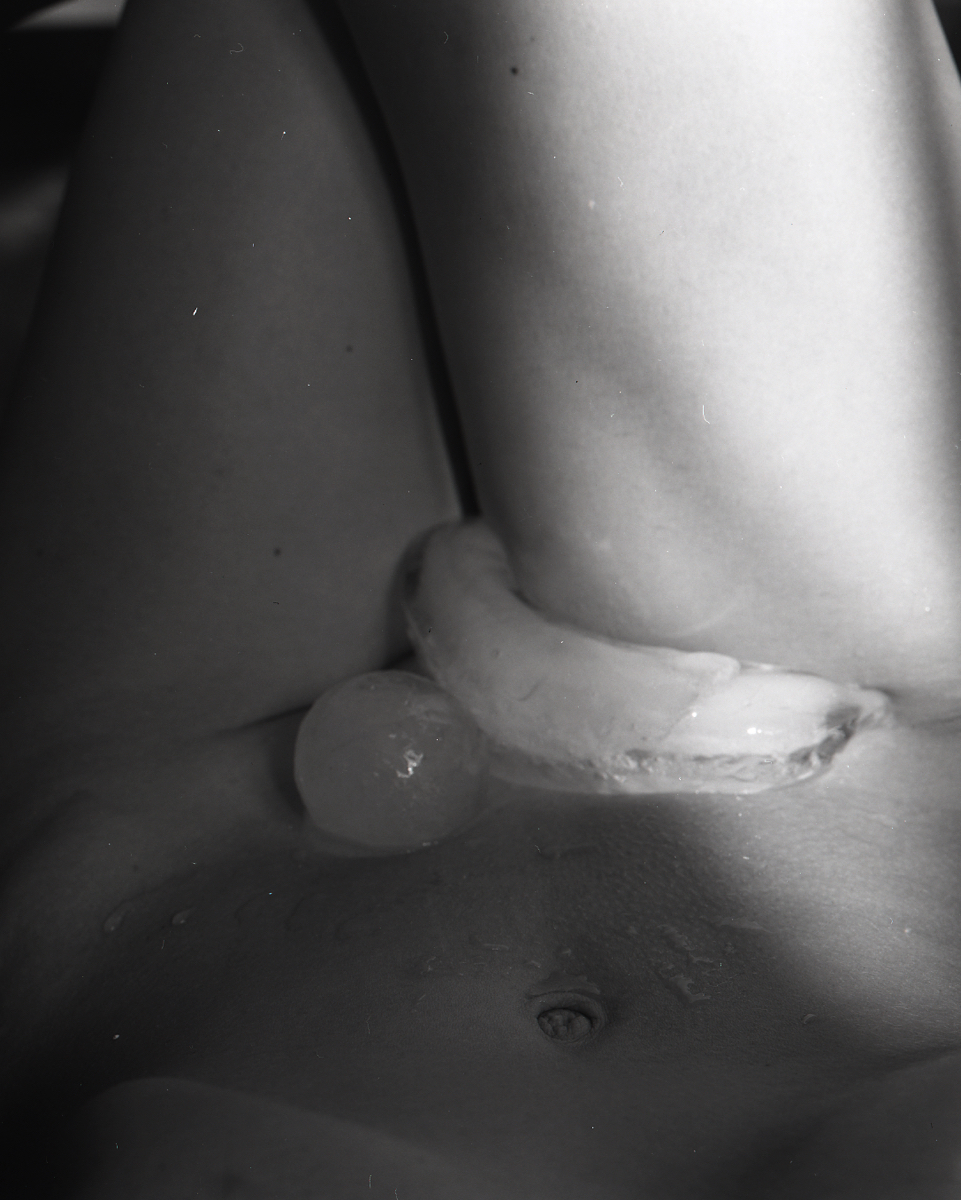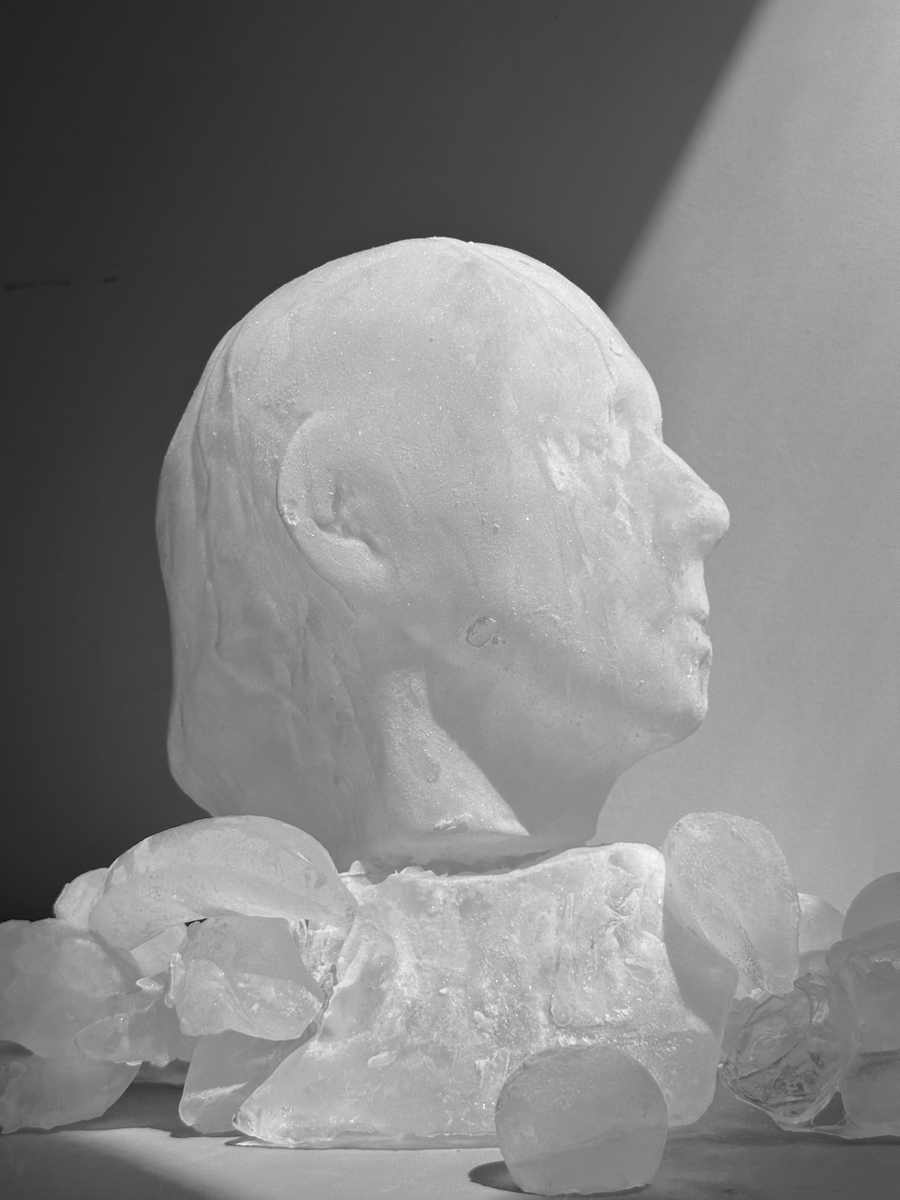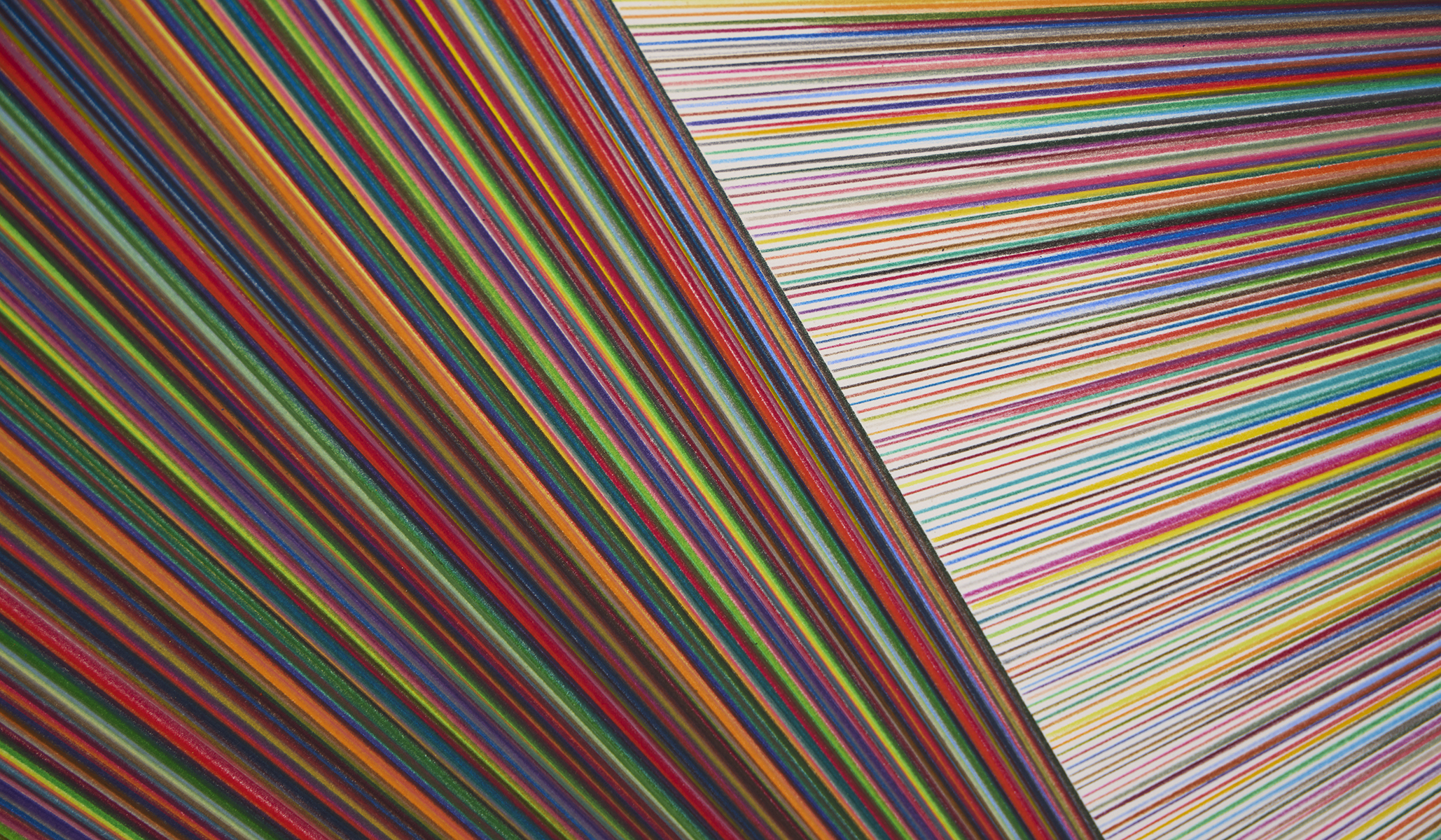“In my studio I make ice humans that are derived from the people who are closest to me. To create bodies is to be a mother or a god. I compose the ice bodies in constellations, saw off parts, hammer at others and let new combinations stick to one another. The ice sculptures are placed in the direct sunlight that enters my studio, where heat materialises as melt and the drama unfolds.
As soon as the bodies encounter the atmosphere outside of their incubating freezer they take on a life of their own. Disparate body parts live out short new existences before they drip into each other and evaporate into nothingness or slide down the drain. Their lives reflect my own life sped up, the longest phase being the creation, then a brief fluid existence and a rapidly escalating disappearance. As I arrange and photograph these delicate and dematerialising bodies I’m filled with a constant sense of urgency.
To create each piece I mold from live models, cast in plaster, layer on silicone, trowel a mother mold and freeze into ice sculptures. There is a tingling sense of pleasure as I birth each creation out of its mold. With it comes a desire to hold on to this new body, a want to see it change and also to remain, yet holding only accelerates the melting. Looking at my own ice body I observe myself from a distance, and watching it melt I speculate what might be in a bodiless life.
The black and white prints in this series reenact my making process and share private moments of studio life. I draw on the intensity of labour, obsessive love, the investigation of my human form and the playful uncanny of engaging with my own mystical existence. In these works, the production of ice sculptures, with its particular processes and tools, comes to the foreground.
In these studio sessions I play in Eden in the moment before “The Fall”- freeze, melt and freeze again, a life and death without consequence. I can try things on, stage experiences as a way to relive and process, and recreate the works of artists and ideas I admire with impermanent materials. I plant a garden of scraps and mourn the disappearance of people, animals, plants and fruits.
This is a space where body becomes site and I envision the shape of things to come. I celebrate my birthday, hold my children’s hands and work until the onset of labor. I photograph myself interacting with my ice body, collate landscapes of our human ruins, reposition myself within my family and reflect on being a woman, a mother and an artist.
Printing these works in a traditional darkroom the elements of water and light return to finalize the images. There are similarities between the artistic processes of photography and mold making: both involve a translation from positive to negative, and dark is to light what space is to form. They are also both capturing a fleeting moment as faithfully as possible, and the paradoxes and absurdity that entails.
To make the colour photographs in this series, I build sets using panels of glass arranged into invisible layers. On the glass panels sit the ice sculptures, and the coloured light surrounding them comes from transparency films I made by photographing directly into light sources.
The transparency films are based on memories of hazily soft pinks and blues in St Petersburg that have affected the work many Russian artists, the translucent skies in Beijing where I spent much time photographing in fog, and the sadly surreal orange colours of the recent New York summer blanketed by smoke from Canadian fires. I’m searching for a light from the future which is partly reflecting and partly passing through. This way of working was influenced by the Russian animation artist Yuri Norstein, particularly his work “Hedgehog in the Fog”.
These molds, and this photography, are a replication, and also an alteration and a deception. All works here were made as straight photographs with a traditional large format film camera. The particulars are assembled as a collage before the camera, existing in that form for at least the duration of the photograph. Whatever enters the setup exists in a flux, living, dying, replicated and reinterpreted, simultaneously new and old.”
Svetlana Bailey, 2024


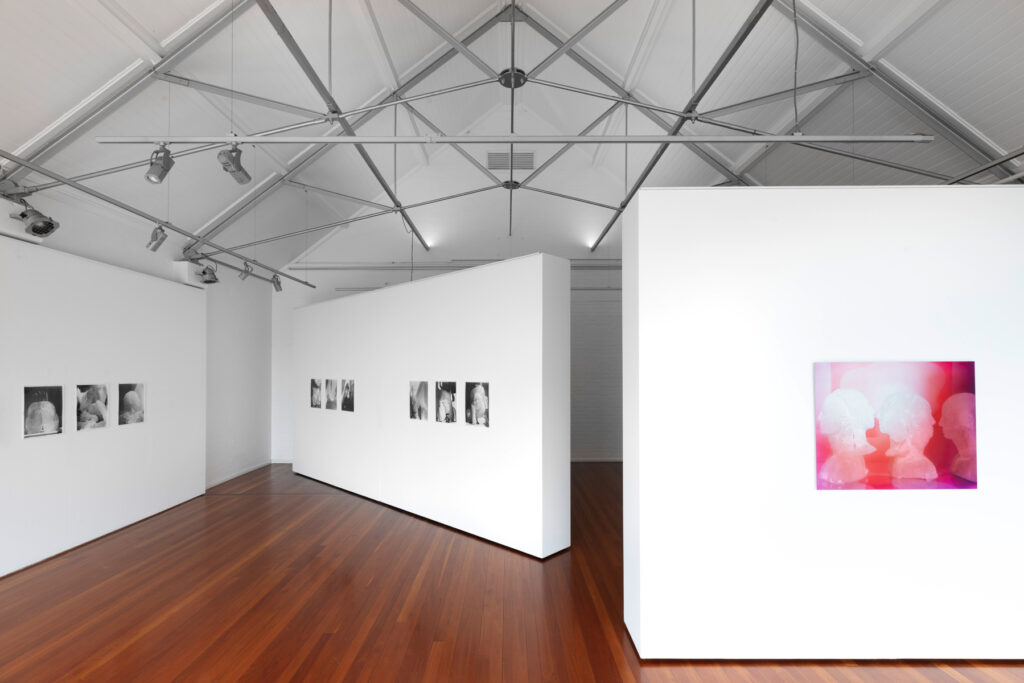

Installation photography by Jessica Maurer.
“The abstraction of the body as vessel and as medium is a constant in Svetlana Bailey’s practice. And the bodies depicted in Bailey’s work are made all the more personal as they belong to the artist herself and her family members. The metamorphic, faded, and transmuted body parts were all cast, moulded, or photographed from the bodies of her mother, her father, her partner, her daughter, her son, and her own self. They represent what it means to inhabit the body, in our own consciousness, and what we might be without our bodies.
In a perfect dichotomy, parts of bodies are recreated out of ice in Bailey’s ‘Who wants to live forever’ series. Frozen in time yet forever changing, the ice sculptures slowly melt away. In a moment of pause, they are re-frozen to build barnacle-like frost on their exterior forms and dissolve their humanly features; then frozen again and again. As the water of these bodily parts drips, their unique human features start to fade – the fine wrinkles, visible pores, fingerprint marks, and traces of hair – so that what remains is no longer human. The final materiality captured on film is without body, without humanness. We are left with an alien form, a trace of what was once a body, a being that is now closer to the natural elements than a beating heart.” – Kelly Price (2023)
All prices are in Australian dollars and inclusive of GST.
Delivery costs not included – please contact the gallery for assistance with delivery.
Prices are correct at the time of publication but may be subject to change without notice.
For sales enquiries email: info@artereal.com.au
Making a living
pigment print
81.3 x 101.6cm
edition of 3 + 1AP
Edition 2: $3,800 unframed
Edition 3: $4,600 unframed
Grandmother's womb
pigment print
81.3 x 101.6cm
edition of 3 + 1AP
Edition 2: $3,800 unframed
Edition 3: $4,600 unframed
Break a leg
pigment print
40.6 x 50.8cm
edition of 3 + 1AP
Edition 2: $1,900 unframed
Edition 3: $2,200 unframed
Mom and Dad
pigment print
40.6 x 50.8cm
edition of 3 + 1AP
Edition 2: $1,900 unframed
Edition 3: $2,200 unframed
Homebody one
pigment print
63.5 x 81.3cm
edition of 3 + 1AP
Edition 2: $3,000 unframed
Edition 3: $3,700 unframed
On the other side
pigment print
88.9 x 71.1cm
edition of 3 + 1AP
Edition 2: $2,700 unframed
Edition 3: $3,500 unframed
Untitled #11, from the series 66% bananas
pigment print
99 x 79cm
edition of 5 + 2AP
Edition 2: $2,400 unframed
Edition 3: $2,600 unframed
Edition 4: $2,900 unframed
Edition 5: $3,300 unframed
Here comes the sun
silver gelatin print
40.6 x 50.8cm
edition of 3 + 1AP
Edition 2: $2,000
Edition 3: $2,200
Framing: $645
Forty trips
silver gelatin print
50.8 x 40.6 cm
edition of 3 + 1AP
Edition 2: $2,000
Edition 3: $2,200
Framing: $645
Mother molder
silver gelatin print
50.8 x 40.6 cm
edition of 3 + 1AP
Edition 2: $2,000
Edition 3: $2,200
Framing: $645
Playing the body
silver gelatin print
50.8 x 40.6 cm
edition of 3 + 1AP
Edition 2: $2,000
Edition 3: $2,200
Framing: $645
Knowledge of good and evil
silver gelatin print
50.8 x 40.6 cm
edition of 3 + 1AP
Edition 2: $2,000
Edition 3: $2,200
Framing: $645
Beets and boobs
silver gelatin print
40.6 x 50.8cm
edition of 3 + 1AP
Edition 2: $2,000
Edition 3: $2,200
Framing: $645
The branches are my children
silver gelatin print
40.6 x 50.8cm
edition of 3 + 1AP
Edition 2: $2,000
Edition 3: $2,200
Framing: $645
The creator
silver gelatin print
50.8 x 40.6 cm
edition of 3 + 1AP
Edition 2: $2,000
Edition 3: $2,200
Framing: $645
Things to come
silver gelatin print
50.8 x 40.6 cm
edition of 3 + 1AP
Edition 2: $2,000
Edition 3: $2,200
Framing: $645
Woman at work
silver gelatin print
50.8 x 40.6 cm
edition of 3 + 1AP
Edition 2: $2,000
Edition 3: $2,200
Framing: $645
The mother of all beings
silver gelatin print
50.8 x 40.6 cm
edition of 3 + 1AP
Edition 2: $2,000
Edition 3: $2,200
Framing: $645
Body as site
silver gelatin print
40.6 x 50.8cm
edition of 3 + 1AP
Edition 2: $2,000
Edition 3: $2,200
Framing: $645
Let down
silver gelatin print
50.8 x 40.6 cm
edition of 3 + 1AP
Edition 2: $2,000
Edition 3: $2,200
Framing: $645
Hold On
silver gelatin print
50.8 x 40.6 cm
edition of 3 + 1AP
Edition 2: $2,000
Edition 3: $2,200
Framing: $645
Eating Fruit
silver gelatin print
50.8 x 40.6 cm
edition of 3 + 1AP
Edition 2: $2,000
Edition 3: $2,200
Framing: $645
After eating fruit
silver gelatin print
50.8 x 40.6 cm
edition of 3 + 1AP
Edition 2: $2,000
Edition 3: $2,200
Framing: $645

